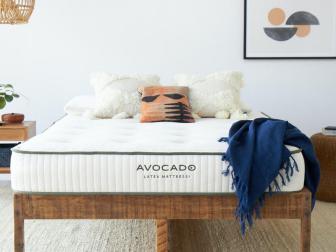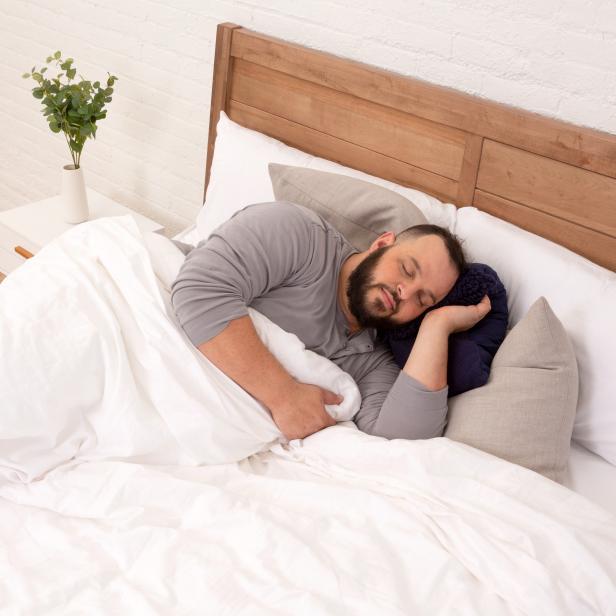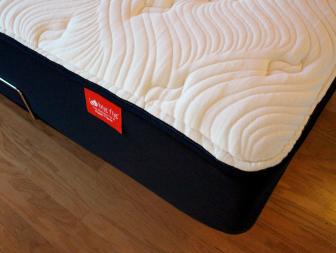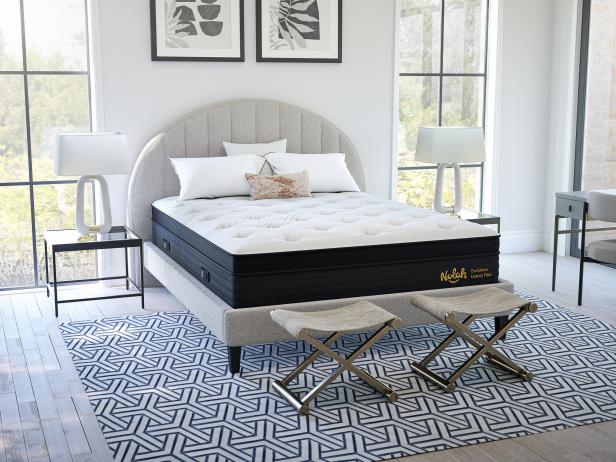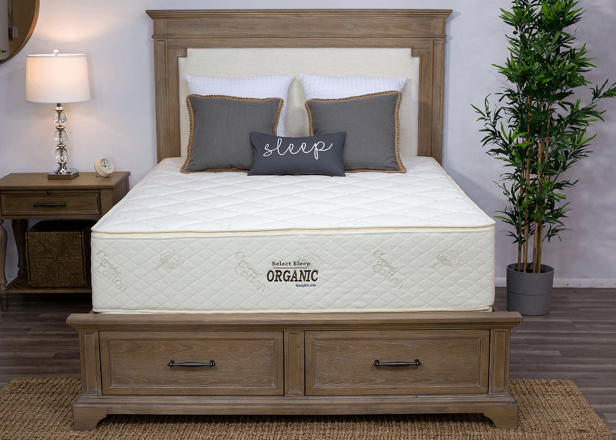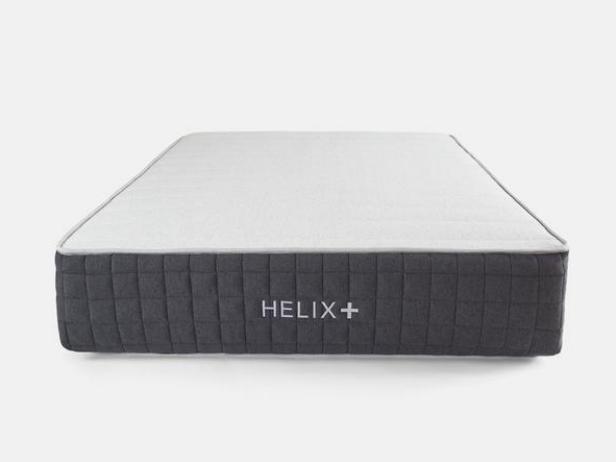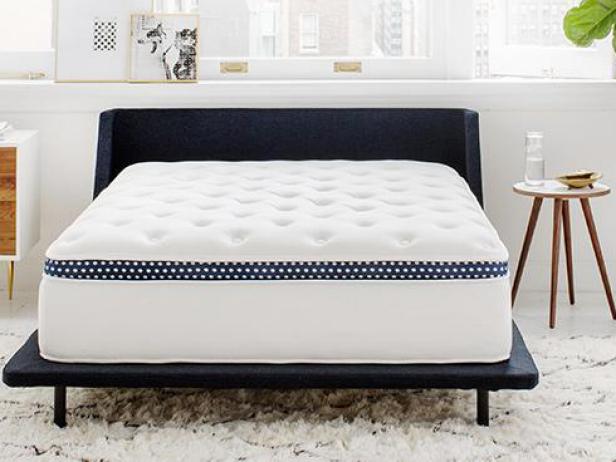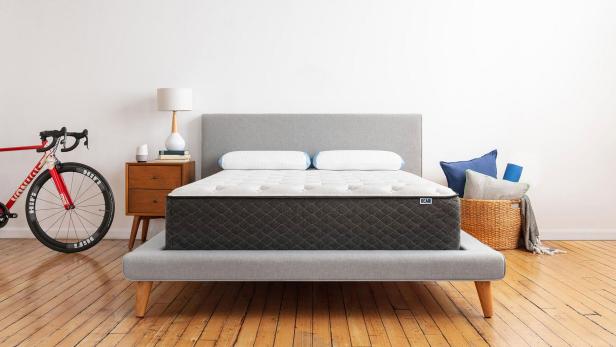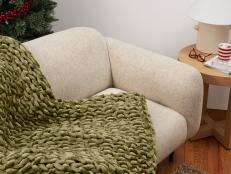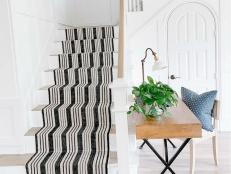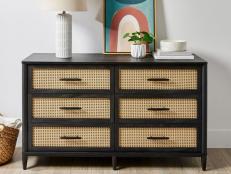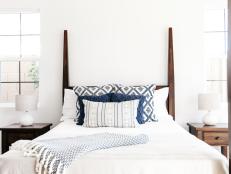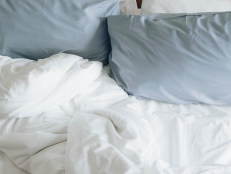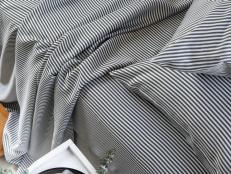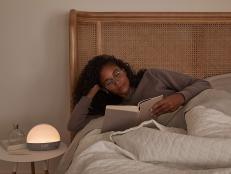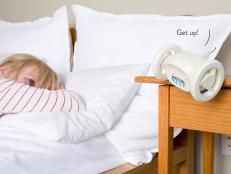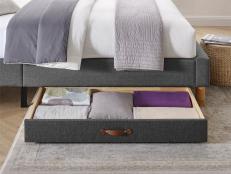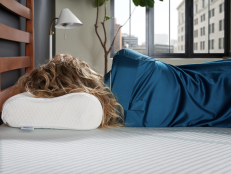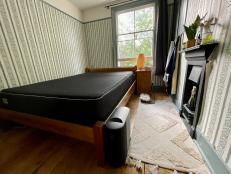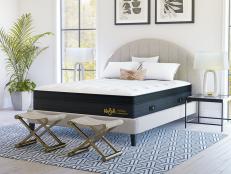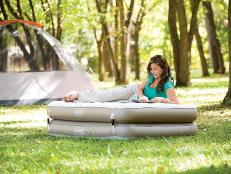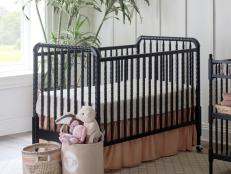The Plus-Size Mattress Guide: The Best Beds for Heavy Sleepers You Can Buy Online
The good, the bad, the affordable — I logged over 75 hours researching durable beds for plus-size sleepers so you don't have to.


I tend to fall into research spirals. When my eight-year-old mattress started sagging, causing me to wake up every morning with horrible back pain, it was no different. I searched every corner of the internet looking for the perfect mattress.
This would prove to be a more difficult task than I thought. Since 2013, the last time I walked into a store and bought a mattress, dozens of online mattress companies have sprung onto the scene – Purple (founded in 2015), Helix Sleep and Casper (both founded in 2014), the list goes on – competing to give tired consumers the best bed-in-a-box experience. Attempting to cater to every sleep style, some companies have been introducing mattresses specifically catered to plus-size adults.
I found this intriguing because I’m 275 pounds and shaped like a pomegranate juice bottle. I’m hard on furniture. I’m honestly surprised my no-name mattress lasted as long as it did, and I wanted my next mattress to be not only comfortable but durable and able to literally put up with me.
So three weeks, hundreds of mattress reviews and a few trips to the mattress store later, I’m sharing my research to help you make an informed decision on a mattress and finally get some sleep, whether you’re 250, 550 or just want a firm, durable mattress.
What’s in a Plus-Size Mattress?
When it comes to mattresses, the term “plus-size” typically refers to big and tall people over 200 to 230 pounds and up, depending on the company – that’s a huge range of weights and body types to cover in one or two mattress models. If you’re curvy, you may need something softer and more conforming than someone who is your same weight but with an athletic build. It only gets more complicated the more factors you consider, like sleep position (stomach sleepers need a firmer mattress to keep their spine aligned) and how you use your bed (if you sit up in your bed and watch TV often, you might need a firmer mattress or adjustable base).
Many plus-size mattresses I found were hybrid models, meaning that instead of all foam or just an innerspring system, the mattress is made up of multiple layers that combine foam, gel, an innerspring system or other materials. While the specs vary from mattress to mattress, most options for heavy sleepers boast more durable foams, heavy-duty coils and advanced edge support (that’s important if you sleep on the edge of the bed or sit on the edge of the bed often). You can also expect to see cooling features like gel-infused memory foam and moisture-wicking mattress covers since larger people typically sleep hotter (I know I do).
All sleepers, not just plus-size ones, should learn about what makes up their mattress to find the best support for them. Consider the factors below and get to know common terms and materials used in mattress making to have a higher chance of finding the right mattress for you the first time.
Mattress Thickness
Mattresses range from around eight to 16 inches tall, some even reaching heights of 20 inches or thicker. Because heavier people put more pressure down on their mattress, pressing further into the layers, mattresses under 10 inches (or even under 12 inches, depending on your size and body type) often won’t be suitable. However, that doesn’t mean that the heavier you are, the thicker the mattress you should seek out, so don’t go adding that 20-inch mattress to your cart just yet.

The Bear Hybrid features layers of memory foam stacked on top of pocketed coils.
What’s in the Mattress Layers?
It’s all about the components – a mattress could be 20 inches, but if all 20 inches are low-quality foams, you still might not get the support you need or you’ll see the mattress quickly deteriorate. Here are some things to look for when shopping:
Memory Foam: Memory foam is man-made, manufactured polyurethane plastic that can have an open- or closed-cell structure. It usually has a slower response rate (also referred to as recovery rate) compared to other materials, meaning that if you press your hand into the foam, it takes some time before it returns to its natural shape. The flexible foam is found in our sponges, insulation and furniture.
In mattresses, it’s beloved for that sink-in feeling and ability to conform to your body shape. It’s also a favorite for its ability to reduce motion transfer across the surface of the mattress – so if your partner gets up in the middle of the night or changes positions frequently in their sleep (or, according to commercials, if you sleep with a full cup of water on the edge of your bed), you shouldn’t feel the movement.
Latex: Natural latex, in its pure form, is a white, milky liquid tapped from rubber trees. Once matured, rubber trees can be tapped for years and years, so latex is said to be a more eco-friendly, sustainable option. Once latex is harvested, it’s sent off for processing to help create products like balloons, adhesive and the bouncy, quick-responding foam that you’ll find in mattresses. There are also two types of natural latex foam: Dunlop and Talalay, with the names and differences coming from the process used to create each. Latex also comes in synthetic forms.
In mattresses, you can find natural latex, synthetic latex or foam that has been blended with latex. Natural Dunlop latex is generally said to be denser and more durable than Talalay, which has more air pockets and is said to have a softer feel, but the differences might be negligible to the average user. Natural latex is more durable than memory foam and can be more expensive. Though it’s not quite as conforming as memory foam, latex does still manage to hug your curves. If you feel like memory foam leaves you feeling “stuck” in your mattress, you should consider latex. Natural latex is also said to be more temperature-neutral and more durable than memory foam.
Foam Density: No matter which option you choose, foams have a density rating, calculated by weighing a 12” x 12” square inch block of foam. So if you have a foam mattress topper that lists a two-pound density, that means it weighs two pounds per cubic square foot of foam. Heavier foams will have higher densities – low-density foams typically weigh three pounds and under per cubic foot, medium-density foams four to five pounds per cubic foot, and anything heavier than that is considered high-density foam. High-density foams are more durable than low-density foams, but also more expensive.
ILD: ILD is an abbreviation of Impression Load Deflection, also referred to as Impression Force Deflection (IFD), used to measure the softness or firmness of foam in mattresses. It’s measured by the pounds of force needed to compress a foam sample to 25 percent of its size. The more pounds needed, the firmer the foam and the higher the ILD. Memory foam usually has a lower ILD (10-15) and is softer, while latex usually has higher ILDs (20+) and is firmer.
ILD shouldn’t be confused with density – two foams can have the same density and different ILDs. Some companies will list their densities and ILDS, others will tell you if you ask, and some keep that information under wraps.
Coils: More durable than foam, springy mattress coils are traditionally made from steel, and come in a few different styles: hourglass coils, pocketed coils (Marshall or encased) and continuous coils (you might see them as the Leggett & Platt branded “Miracoil”).
There are two types of hourglass coils: Bonnell and offset, with the latter having a square top and bottom that create a more supportive, contouring base and help reduce motion transfer. A continuous-wire coil system consists of one piece of steel that is bended into individual coils; it’s inexpensive but durable, but you’ll notice more motion transfer and less contouring. Pocketed coils systems use coils (typically cylindrical coils) that have been individually wrapped in a fabric sleeve. This helps reduce noise and motion transfer and allows each spring to react independently from each other for better conforming. Pocketed coils are typically the most expensive option. You may also see microcoils, dozens or hundreds of miniature, high-gauge coils that are also fabric-encased and great for contouring, used in mattresses as comfort layers instead of a support system.
Coil Gauge: Coil gauge is a measurement of the thickness of the wire used to make mattress coils. The lower the gauge, the thicker (and firmer) the coil – typically ranging from 12 to 15 in mattresses. Mattress makers can blend different gauges of coils for different reasons – for example, a mattress could feature 13-gauge coils around the perimeter for edge support, but 15-gauge coils in the center of the mattress for a softer feel. A mattress company also might boast more coils than their competitors, but this is also why it’s important to pay attention to the gauge.
The Mattress Cover
Mattress covers can be made out of cotton, eco-friendly bamboo, wool, hybrid blends of cotton and polyester, and more. Heavier sleepers should generally look for more breathable materials so they don’t get too hot at night, but remember that the sheets and blankets you use will play a huge factor in sleeping hot or cool, too.
Cooling Bedding for Hot Sleepers
Weight Capacity of Mattress
When looking at mattresses, check to see if the company or specific model has a recommended weight capacity – you may have to look around their website or connect with a live agent. Consider the full capacity of the bed. If you and your partner were only a combined weight of 300 pounds, but you sleep with two 80-pound dogs in the bed, then your combined weight is actually 460 pounds. You’d need a more durable mattress than someone who is 200 pounds and sleeps alone.
What’s in a Mattress Foundation?
Foundations provide a base for your mattress to sit on. Some foundations are more like traditional box springs, constructed of either wood or metal and covered with fabric. These types of foundations are usually paired with a metal base or sit on the floor inside a bed frame. Other foundations consist of a series of open metal or wood slats. You should consider the foundation’s weight capacity (remember to include the weight of the mattress!) and the size and spacing of the slats. For heavier sleepers, wider slats that are spaced closer together will be more supportive. In most cases, companies will want you to use a foundation with slats that are spaced no wider than five inches apart. If you’re using an existing foundation, you should always contact the company to make sure your foundation is approved for your new mattress. Failing to use an approved foundation can void your warranty.
Mattress Warranty
Make sure to get an understanding of the mattress company’s warranty, how long it is and what it covers. For example, most companies will cover dips or indentations up to a certain depth (usually 1.5 inches or greater), but it’s only covered if the dip can be measured when there’s no weight on the bed. Other non-covered issues often include softening, which is usually considered normal wear-and-tear, and whether the mattress is comfortable or not. There are also a variety of things that can void your mattress, like using an improper foundation or stains (for this reason, I recommend always using a mattress protector).
The Mattresses
As I’m sure you can tell by now, there are seemingly endless factors when it comes to choosing a mattress no matter what size you are. It’s a highly personal decision, and that’s why it’s so important to have a basic understanding of the makeup of your mattress. Now that you’re armed with more knowledge on what to look for in a mattress, check out my top mattress picks for heavy sleepers below, sorted by weight capacity.
Able to support two 550 sleepers, the Big Fig (short for Bigger Figure) mattress will be one of the more durable bed-in-a-box options for a heavy sleeper. Though Big Fig was founded in 2016 by Alison Goodman and her father Bruce Goodman, the family has been in the mattress industry for decades.
PRICING: $1,399 - $2,699 (7 sizes available)
THICKNESS OPTIONS: 13 inches
WHAT’S IN THE LAYERS: One layer of gel-infused, ventilated latex foam; one layer of 1.8-pound polyurethane foam; two layers of 2.5-pound polyurethane foam; 80 ILD foam for edge support; 15-gauge pocket coils
WEIGHT CAPACITY: 1,100 pounds with two sleepers (in Queen, King or Cal King mattress sizes) or up to 550 pounds with a single sleeper (on any mattress size)
TRIAL PERIOD LENGTH: 120 nights; you must sleep on the mattress for at least 14 days before trying to initiate a return
RETURNS & WARRANTY: Returns are free – Big Fig will help coordinate a pickup and refund your money once the old mattress is removed. Big Fig comes with a 20-year warranty; in the event of a defect, Big Fig will replace or repair your mattress.
Nolah Sleep boasts their mattresses as “The Best Mattress for Side Sleepers.” Their most popular mattress, the Nolah Evolution 15, is composed of foam and coils and topped with a plush, quilted two-inch pillowtop. Nolah has its own foam, AirFoam™, which is said to be more responsive, durable and temperature neutral than memory foam.
PRICING: $1,599 - $3,598 (7 sizes available)
THICKNESS OPTIONS: 15 inches
WHAT’S IN THE LAYERS: Two-inch cooling ArcticTex™ quilted euro top; two inches of graphite-infused AirFoamICE™; two-inch foam transition layer, eight-inch coils wrapped encased in foam for edge support, one-inch foam base layer
WEIGHT CAPACITY: 350 pounds on Twin, Twin XL and Full models, up to 700 pounds on all other models. When I spoke with a rep from Nolah, they stressed that the mattresses can accommodate heavier weights without fear of voiding the warranty, but that the materials will soften and wear more quickly.
TRIAL PERIOD LENGTH: 120 nights; you must sleep on the mattress for 30 nights before you can initiate a return
RETURNS & WARRANTY: In the event of a return, Nolah will coordinate pickup of your mattress and refund you after the mattress is removed. Nolah offers a lifetime warranty; in the event of a defect within the first 15 years, Nolah will repair or replace the mattress. Past the 15-year mark, the consumer becomes responsible for repair-related shipping fees or a mattress could be replaced at a prorated charge.
Things change, and this all-latex mattress from Sleep EZ can change with you. Sleep EZ features a tool on their website where you can enter your and your partner’s height, weight and preferred sleep position, and they’ll recommend a build with layers of either Dunlop or Talalay latex in varying degrees of firmness. The organic mattress comes with a zippered cover, and you assemble the layers yourself – this means that later down the road if you need to adjust the support by swapping out a layer, you can. If you’re planning on buying a king bed, Sleep EZ recommends going with a split king from the very start. Based out of Tempe, Arizona, Sleep EZ has been in the latex mattress business for over 45 years. If you’re on the fence about latex, don’t hesitate to reach out – I chatted with a representative and found Sleep EZ had great customer service. You can also request samples of latex. If you’re lucky enough to be in the Phoenix Metro area, you can test out their mattresses in person – just call to set up an appointment.
PRICING: $1,199 - $2,099 (8 sizes available, with two split options)
THICKNESS OPTIONS: 7 inches, 9 inches, 10 inches, 13 inches (we recommend heavier sleepers go with a 13-inch)
WHAT’S IN THE LAYERS: Natural Dunlop or Talalay latex foam, ranging from soft (ILD 19-22) to extra-firm (ILD 44)
WEIGHT CAPACITY: Sleep EZ does not list a weight capacity; heavier sleepers opt for firmer layers
TRIAL PERIOD LENGTH: 90 nights
RETURNS & WARRANTY: You can exchange a layer or return the mattress for a refund within 90 days less a $99 return fee. Layer exchanges are $30 for the first time and full shipping cost for any exchanges after the first one. Sleep EZ covers defects for the first 10 years; after 10 years the warranty includes a pro-rated cost on a sliding scale. The customer pays for shipping. Note that the mattress cover has a one-year warranty.
Coming to you from the same company that made the Allform sofa, Helix Sleep is all about personalization. Offering a standard and “Luxe” version of each of their mattresses, the company offers 14 different models (even an organic one called the Birch), each individually rated by firmness and sleep position. Helix Sleep encourages consumers to take its Sleep Quiz to find the perfect match; if you’re on the fence between two models, Helix Sleep also offers a side-by-side comparison tool to match up individual specs. The Helix Plus, previously referred to as the Helix Nightfall, features a 4-pound memory foam layer and a layer with Helix’s own hybrid latex-foam blend. If you’re interested in something firmer or softer, Helix recommends going with one of their Luxe models.
PRICING: $649 - $1,499 (6 sizes available)
THICKNESS OPTIONS: 13 inches; Luxe models are 14 inches
WHAT’S IN THE LAYERS: Four-pound memory foam, a latex-foam hybrid layer, memory foam, pocketed coils, polyfoam
WEIGHT CAPACITY: 500 pounds for one sleeper and 1,000 pounds for two sleepers
TRIAL PERIOD LENGTH: 100 nights; you must sleep on the mattress for 30 days before you can initiate a return
RETURNS & WARRANTY: In the event of a return, you can contact Helix to arrange a pickup. Once the removal is complete, Helix will refund your money. The Helix Plus comes with a 15-year warranty – in the event of a covered defect, Helix will repair or replace the mattress. (Note: at the time of writing, there are a couple of spots on Helix’s website where it says the warranty for the Plus is 10 years, but I’ve confirmed it’s 15 years.)
If you need something supportive and affordable, try Titan by Brooklyn Bedding, a line created specifically for plus-size sleepers. There are two options available, the original Titan and the recently introduced Titan Luxe, a medium firmness mattress for heavy side sleepers and those who like a softer mattress. You can add an optional phase-change fabric top cooling panel if you sleep hot.
PRICING: $699 - $1,499 (7 sizes available, including a split Cali king)
THICKNESS OPTIONS: Original Titan Firm: 11 inches; Titan Luxe: 13 inches
WHAT’S IN THE LAYERS: One-inch layer of quilted, gel memory foam; two-inch layer of Titan’s patented foam; six-inch core of 13.5 gauge individually-wrapped coils; two-inch layer base foam
WEIGHT CAPACITY: Up to 1,000 pounds
TRIAL PERIOD LENGTH: 120 nights, you must sleep on the mattress for 30 days before you can initiate a return
RETURNS & WARRANTY: Brooklyn Bedding will try to work with you on the current mattress before a return comes necessary – for example, they might send you a topper if the bed is too firm. If a return becomes necessary, Titan may ask you to try to donate the mattress and provide a receipt of donation before refunding; if a donation isn’t possible, Titan will coordinate a pickup with a local recycling company. The warranty is 10 years, in the event of a defect Brooklyn Bedding will replace or repair your mattress.
WinkBeds boasts a sturdy design and American craftsmanship – their mattresses are made in Watertown, Wisconsin, and Orlando, Florida, and you can watch videos of the mattress being made on their website. All WinkBed models have a similar look and shared features, including a Euro-pillowtop and enhanced edge control, but the Plus model is beefed up with a higher-density foam and a 2.5-inch pure latex layer. Though WinkBeds sells their mattresses online, there are currently seven showrooms where you can test out the WinkBed in person.
PRICING: $1,349 - $2,199 (6 sizes available)
THICKNESS OPTIONS: 13.5 inches
WHAT’S IN THE LAYERS: “Anti-sag” foam with a minimum density of 1.8 pounds per cubic foot, 2.5-inch layer of zoned latex, 5-Zone EliteEdge individually-wrapped support coil
WEIGHT CAPACITY: Up to 900 pounds
TRIAL PERIOD LENGTH: 120 nights; you must sleep on the bed for 30 nights before trying to initiate a return or exchange. If you want to switch to a different firmness within the trial period, WinkBeds offers exchanges for $49 and you will get a new 60-day sleep trial. If you want to switch to a different mattress or want a new one any time after the trial ends, WinkBeds will offer 50 percent off the current price of the new mattress, up to one replacement per household.
RETURNS & WARRANTY: WinkBeds coordinates return, once the pickup is complete they will refund your money within five days, though note that this does not include any white glove delivery or shipping costs that were added on to your original purchase. WinkBeds has a lifetime limited warranty; in the event of a defect, WinkBeds will replace your mattress in the same size and model.
Founder Scott Paladini sold his brick-and-mortar mattress store (to his father, who is also in the mattress biz) to focus his efforts on Bear. The mattresses have a Celliant fiber top, which “transforms your body’s heat into full-spectrum infrared energy, promoting local circulation and cell oxygenation while keeping you drier and at the perfect temperature.” This makes Bear a hit with athletic and hot sleepers. My recommendation for heavy sleepers, the memory foam and coil Bear Hybrid, is the only mattress on the list that features edge-to-edge pocketed coils.
PRICING: $1,298 - $2,796 (6 sizes available)
THICKNESS OPTIONS: 14 inches
WHAT’S IN THE LAYERS: Quilted Celliant fiber top, cooling gel memory foam, a comfort layer of memory foam, a transition layer of foam, 8 inches of pocketed coils, a base layer of foam
WEIGHT CAPACITY: 700 pounds, or 350 pounds per sleeper
TRIAL PERIOD LENGTH: 100 nights, but you must sleep on the mattress for 30 days before initiating a return
RETURNS & WARRANTY: Returns are free – Bear will coordinate a pickup of the mattress and attempt to donate it to a local charity in your area. The Bear Hybrid Pro is covered by a 20-year limited warranty. During the first 10 years, Bear covers costs associated with replacing or repairing the mattress. From years 11 to 20, Bear can replace the mattress at a pro-rated charge dependent on what year the mattress is replaced, starting at a 55 percent charge to the consumer in the 11th year.
Purple blasted onto the scene with its witty ads and its bouncy, rocket scientist-designed gel grid in 2015. Since then, Purple has released a variety of mattresses, including their Hybrid Premier line, which contains three or four inches (commonly known as the Purple 3 and 4, respectively) of their signature Purple GelFlex on a support layer of foam and pocketed coils. Purple recommends the Purple 4 for full-figured sleepers, especially if they’re a side sleeper. The open grid makes for a cooler slumber than other materials. Sleepers are often divided on the Purple – the grid crushes under your weight, conforming to the heavier parts of your body, making for a unique feel. I’ve seen it described as “crunchy” and like “popping bubble wrap” (you can definitely feel the grid “pop” as your body settles into it). As one of the most expensive options on the list, I’d recommend trying out the Purple at a local mattress store – in my case, I’ve tested the Purple at both Mattress Firm and Rooms-to-Go. Call before you go, as your local store might only have certain models.
PRICING: $3,199 - $6,398 (6 sizes available, including a split Cali king)
THICKNESS OPTIONS: 13 inches
WHAT’S IN THE LAYERS: Four-inch Hyper-Elastic Polymer™ Purple Grid; one-inch layer of two-pound density polyurethane foam; 7.5” pocketed springs
WEIGHT CAPACITY: 300 pounds per sleeper, or 600 pounds total
TRIAL PERIOD LENGTH: 100 nights, you must sleep on the mattress for at least 21 days before initiating a return
RETURNS & WARRANTY: In the event of a return, you will be refunded the full product price of the mattress less the value of any discount, interest accrued and/or shipping charges. Purple mattresses have a 10-year warranty; in the event of a defect, the customer is responsible for to-and-from shipping charges and any inspection costs associated with repairs or replacements. The cover is warrantied for two years, and the customer would pay any transportation, handling and inspection costs in the event of a repair or replacement.







